
By Jim O’Neal
It is hard to ignore the significance of July 14, despite my previous recap of the key events that took place in Paris over 200 years ago when revolutionaries and mutinous troops stormed the Bastille, the royal fortress and prison (with only seven inmates) that symbolized the tyranny of monarchy. It was an event that degenerated into a chaotic bloodbath, but shaped modern nations by exhibiting the power inherent in the will of the common man.
However, I felt a tinge of sympathy for President Donald Trump when I saw pictures of him at dinner last week at the Eiffel Tower (at the Jules Verne restaurant). There is nothing quite so boring as a three-plus-hour dinner at a Michelin-starred French restaurant. I also presume that with President Emmanuel Macron playing host, the kitchen really exaggerated the occasion since he appears to share the classic pomp and monarchical tendencies that got his predecessors in trouble.
This especially includes the last Queen of France, Marie Antoinette, the 14-year-old Austrian princess who had the misfortune of wedding the last King of France, Louis XVI, since they both got their heads chopped off. Their marriage was intended to seal the alliance between longtime enemies Austria and France, following the end of the Seven Years’ War.
Marie Antoinette was born in 1755 in Vienna, Austria, the daughter of the Holy Roman Emperor Francis I and Maria Theresa, the powerful Habsburg Empress. The teen bride-to-be had been delivered to the French on May 7, 1770, and then escorted to the Palace of Versailles, where she met her husband-to-be, Dauphin Louis-Auguste, a 15-year-old boy with a medical condition that rendered him impotent for several years. Eventually, the couple had four children.
The king lost his head on Jan. 21, 1793. Nine months later, a Revolutionary Tribunal found the queen guilty of treason, sexual promiscuity and a phony charge of having incestuous relations with her son Louis-Charles. The trial lasted two days and the tribunal unanimously condemned her to death. On Oct. 16, 1793, the executioner entered her cell wearing a red hood; he sheared off her hair to ensure a quick, clean cut of the guillotine blade.
He then lopped off her head as a boisterous crowd watched and cheered “Vive la nation!”
The 37-year-old queen has long been wrongly charged of responding “Let them eat cake” when told of starving peasants with no bread to eat. Some credit the phrase to philosopher Jean-Jacque Rousseau. I doubt she resents this final insult, but it does represent the conditions that fueled the revolution that rocked the European landscape in general.
 Intelligent Collector blogger JIM O’NEAL is an avid collector and history buff. He is president and CEO of Frito-Lay International [retired] and earlier served as chair and CEO of PepsiCo Restaurants International [KFC Pizza Hut and Taco Bell].
Intelligent Collector blogger JIM O’NEAL is an avid collector and history buff. He is president and CEO of Frito-Lay International [retired] and earlier served as chair and CEO of PepsiCo Restaurants International [KFC Pizza Hut and Taco Bell].

